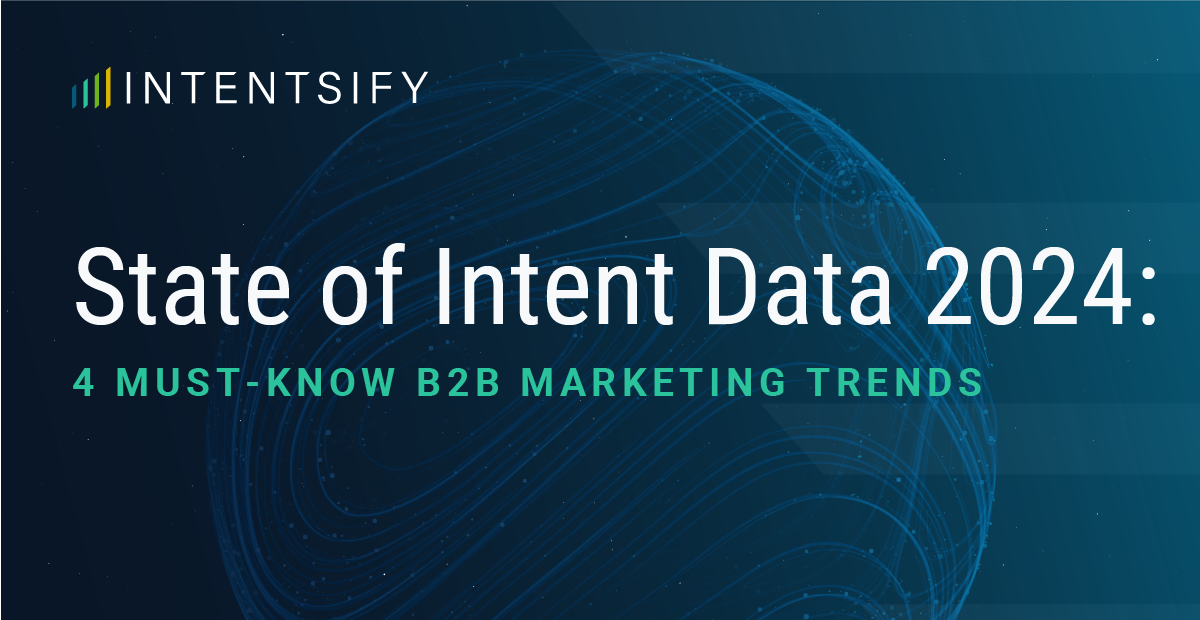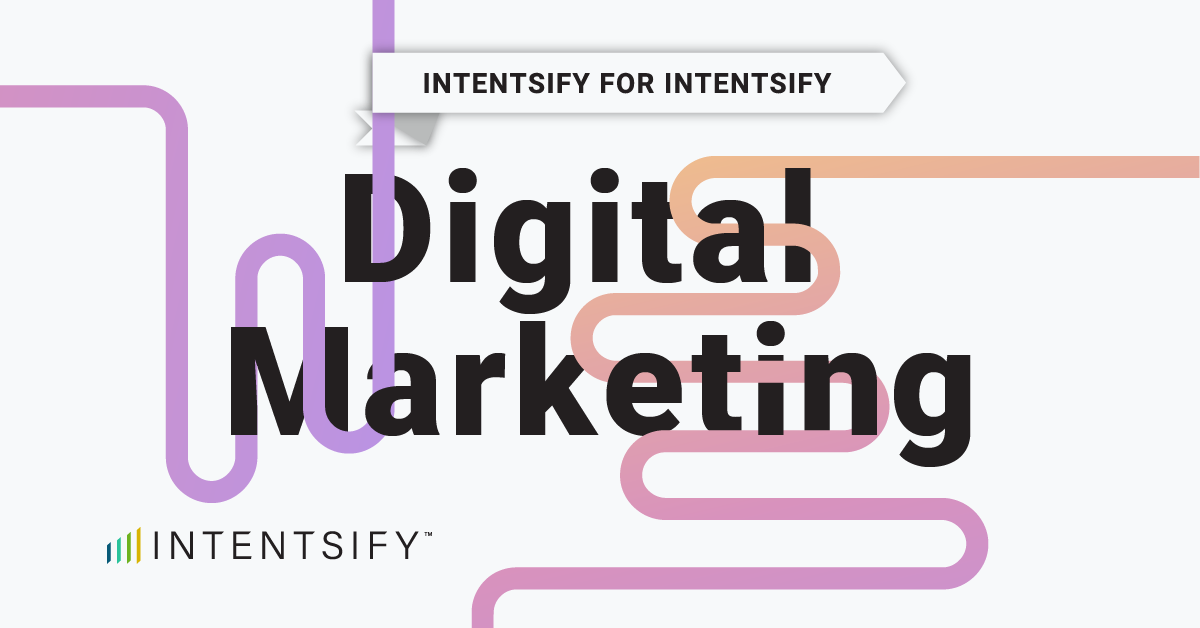Account-based marketing (ABM) has been around for a while—with 98% of B2B marketers currently using or planning to implement an ABM strategy, it’s not a trend fading anytime soon.
And when it comes to ABM, success relies on the data driving your strategy and supporting programs. That’s why many B2B marketers are using “intent monitoring tools” (42% according to DemandGen, and 59% according to Ascend2) to help inform their account-based strategies—outperforming other technologies like measurement/reporting tools, web/content personalization tools, etc.
Intent data reveals crucial insights go-to-market teams (i.e., marketing, sales, and customer success) must know about their target accounts and customers. Intent signals identify who’s in an active buy-cycle (and at what stage), helping you prioritize specific accounts based on their latest research behaviors. Moreover, intent insights help these teams understand what issues prospects and customers are most concerned with, so they can appropriately tailor their messages and outreach tactics.
Effectively using intent is becoming more critical than ever for achieving ABM success. In fact, by the end of 2022, Gartner reveals that over 70% of B2B marketers will be using third-party intent data to reimagine their ABM programs.
With that, here are 5 ways you can use intent data to amplify your account-based strategies and boost program results.
1. Define and Prioritize Your Targets
Getting your target-account list (TAL) right is one of the most important variables that can dictate ABM success. Yet Salesforce’s 2021 State of Marketing report reveals that only 39% of marketers are completely satisfied with their “identification of target accounts” for ABM. For such an important step, that figure should be much higher.
This is where intent data becomes your ally—it helps validate the quality of your TAL (i.e., determine if accounts are “in market”), as well as discover unknown accounts that may fit your ideal customer profile (ICP) but aren’t yet included in your list. Unfortunately, only 21% of marketers currently use intent to identify/predict new accounts/industries they should be targeting.
When using intent to validate your current target-account list—ask your intent data provider to run two reports: the first using your TAL, the second using broader targeting parameters based on your ICP (and suppressing accounts currently on your TAL). By comparing the performance of lists against each other, you may find there are more ICP-fitting accounts on your non-TAL being identified as “in market” and showing higher intent scores vs those in your original TAL (or vice versa).
By helping you fine-tune your target-account selection, intent data not only helps expand your net of target accounts—it helps ensure success flows downstream into your other marketing activities.
2. Develop a Content Marketing Plan
Engaging prospective buyers with relevant content will always perform better than sending generic, one-size-fits-all messages. And as you’re competing for their attention against numerous competitors, it’s critical that you create unique experiences that help differentiate your brand. Kristina Jaramillo at Personal ABM further explains:
“When you treat all ‘in market’ accounts the same and just create buyer journeys based on what prospects are searching for, you work off general assumptions about the organization’s needs and pain points. This is the same information that your competitors are responding to, so there is no real differentiation from others using intent data platforms.”
Intent data can help you understand where target accounts are in their buyer’s journey—as well as the issue they care most about—so you can select the right messages, content, and engagement tactics (which we’ll discuss in the next section) to use for each “in market” account. By revealing the topics “in market” accounts are specifically interested in, intent data can guide the development of content—including specific formats to use—for segmented accounts at each stage of the buyer’s journey. You can then create a messaging and content matrix that maps intent signals, to journey stages, to content assets.
Using intent data to inform content marketing in your ABM efforts not only helps accelerate the sales cycle—it improves efficiency by ensuring teams aren’t wasting time and resources creating irrelevant content for accounts that shouldn’t be prioritized, allowing you to continue scaling programs while maintaining intimacy with Tier 1 accounts.
3. Set Up and Launch Account-Targeted Paid Media Programs
As we know, the buyer’s journey is rarely linear. During their research, prospects are using different websites, tools, and channels to help them understand their problem and ultimately find a solution. That’s why it’s optimal to use a combination of engagement tactics to ensure messages are getting in front of the right decision-makers at target accounts.
To help, teams are increasingly turning towards intent data to amplify their paid media efforts, adding an extra layer of targeting precision across digital advertising and paid lead generation programs (e.g., content syndication). Our preliminary research report substantiates this—revealing that in 2022, the top intent data use cases among 600+ organizations are “digital advertising” (42%) and “lead generation” (35%). [1]
Surrounding target accounts with your brand-specific messaging relevant to their identified challenges and pain points is the first step towards ABM success. Combining intent data and programmatic advertising is a powerful way to accomplish this task. Not only will intent signals tell you which accounts are “in market” (i.e., which ones you should target), they’ll also inform you of which challenges they’re most concerned with, so you can select the creative assets that will resonate with each account.
Using programmatic in this way lays a solid groundwork for more direct demand-generating efforts, such as content syndication initiatives, LinkedIn ad campaigns, etc. Running intent-driven lead generation campaigns in tandem with programmatic advertising campaigns helps boost the impact of individual channels and increases the likelihood that your messaging and content will get in front of and resonate with decision-makers at target accounts.
4. Align Marketing, Sales, and Customer Success
Marketing, sales, and customer success teams should be involved in the planning of your ABM program early on—from agreeing on target accounts to establishing lead hand-off processes and expanding investments from current customer accounts.
When my team launched an ABM program last fall, for example, our VP of Marketing worked with both sales and customer success executives on building our account-based strategy for at least two months. Throughout this entire process, intent data was used, providing:
- Marketing intelligence for ICP creation, brand positioning and messaging; and
- Account intelligence for TAL creation, engagement tactics, scoring models, and nurture tracks.
Working off the initial strategy, marketing then created custom deliverables (e.g., messaging and content matrix, content and creative assets, landing pages, email nurture tracks) for each campaign. We then aligned with sales to refine lead scoring, routing, and follow-up processes via HubSpot.
5. Analyze Results and Optimize Your ABM Programs
Once you launch your ABM program and start analyzing results across campaigns, it’s important to keep in mind that the intent data topics and keywords you chose to monitor will affect a lot—and your optimizations will likely be around this key component.
For example, it’s important to understand which intent data topic and/or keyword signals are proving to be the most important for which funnels stages and use cases. From there, you can optimize your selection of topics and keywords for each use case accordingly. Moreover, it’s a good idea to assign intent topics and keywords to your messaging, persona, and buyer journey stages in your messaging and content matrix I previously mentioned.
[1] Preliminary “The State of Intent Data 2022” Research Report (Ascend2/Intentsify)






